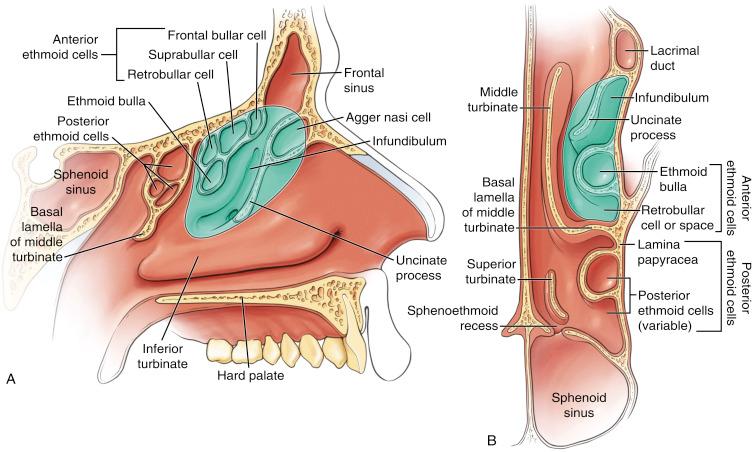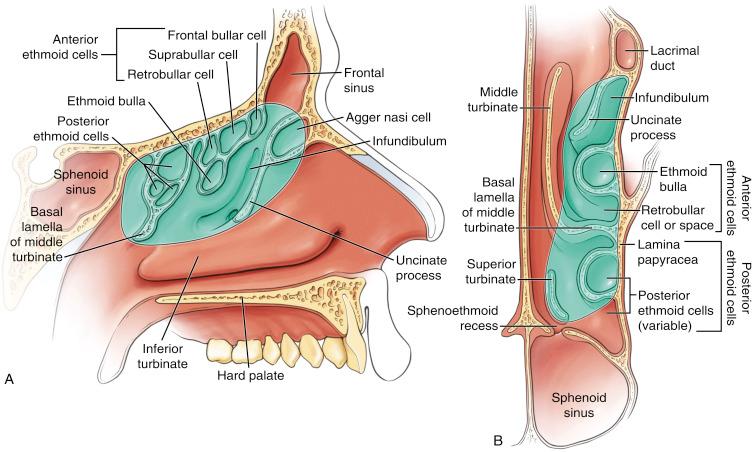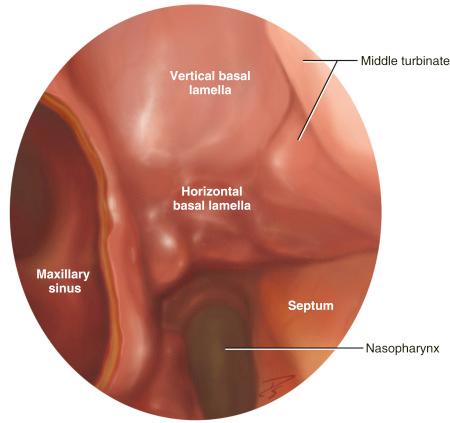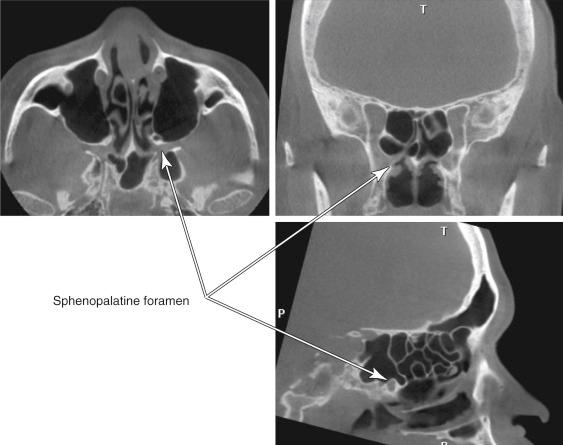Physical Address
304 North Cardinal St.
Dorchester Center, MA 02124
The terms partial and complete ethmoidectomy refer to the removal of the anterior and posterior ethmoids ( Figs. 7.1 and 7.2 , respectively).


A partial ethmoidectomy is the removal of the ethmoid bulla and any cells against the medial orbital wall anterior to the basal lamellae.
A partial ethmoidectomy is often combined with a maxillary antrostomy and termed mini–FESS. The most common indication is recurrent acute rhinosinusitis or nonpolypoid chronic rhinosinusitis involving mainly the maxillary and anterior ethmoids.
A complete ethmoidectomy is the removal of the anterior and posterior ethmoid air cells.
A complete ethmoidectomy follows a maxillary antrostomy and is one component of complete functional endoscopic sinus surgery.
Complete removal of all ethmoid cells entails the “skeletonizing” of the medial orbital wall and skull base of all ethmoid bony partitions.
The safest method of performing a complete ethmoidectomy is to remove the inferior anterior and posterior ethmoid cells until the sphenoid face is reached, then identify the skull base at the posterior ethmoid or sphenoid sinus roof and dissect along the skull base from a posterior to anterior direction.
Indications for a complete ethmoidectomy include the following:
Chronic rhinosinusitis with polyps
Revision surgery for chronic rhinosinusitis
Disease in the posterior ethmoids and sphenoid sinus
The anterior ethmoids are those cells that lie anterior to the basal lamella (portion of the middle turbinate that attaches to the lateral nasal wall).
The anterior ethmoid air cells consist of the ethmoid bulla, agger nasi cell, and those cells that lie against the medial orbital wall.
The space just posterior to the ethmoid bulla and anterior to the basal lamellae is termed the retrobullar space.
The posterior ethmoid air cells are those that lie posterior to the basal lamellae and anterior to the sphenoid sinus.
The posterior ethmoid cells can consist of anything from a single cell to multiple layers of cells. They are bordered laterally by the orbital apex and superiorly by the skull base.
Anatomically, the basal lamella is the portion of the middle turbinate that attaches to the lateral nasal wall.
Functionally, the basal lamella is the bony-mucosal junction between the anterior and posterior ethmoid air cells.
There are two components of the basal lamellae ( Fig. 7.3 ):
Vertical portion
Horizontal portion

Handling of the basal lamellae is extremely important. Excessive resection of the horizontal portion of the basal lamellae can result in destabilization of the middle turbinate. Destabilization can lead to lateralization of the middle turbinate and postoperative obstruction of the middle meatus and frontal recess. However, if the surgeon is too conservative and the vertical portion of the basal lamella is not dissected inferiorly enough, surgeons can often dissect too far superiorly in the posterior ethmoid cavities as they are working toward the sphenoid sinus. Optimally, the vertical portion of the basal lamella is fully removed and the horizontal portion is preserved.
An Onodi cell is a posterior ethmoid cell that lies superior and/or lateral to the sphenoid.
Onodi cells are important to identify preoperatively because the optic nerve traverses the roof of these cells.
When a complete ethmoidectomy is performed, a greater palatine or sphenopalatine artery injection of 1% lidocaine with 1:100,000 epinephrine can be helpful in controlling intraoperative bleeding.
A sphenopalatine artery injection is performed transnasally. Identify the inferior attachment of the middle turbinate to the lateral nasal wall and inject roughly 1 cm above the inferior border ( Fig. 7.4 ) with 1 to 2 mL of 1% lidocaine with 1:100,000 epinephrine. Often, a curved tonsil needle or spiral needle is needed to reach the appropriate position.

A greater palatine artery injection is performed through the mouth. The greater palatine canal is in the hard palate, usually medial and posterior to the second molar. Bend a 27-gauge needle at 1.5 to 2 cm from the tip, identify the foramen, aspirate, and then inject with 1 mL of 1% lidocaine with 1:100,000 epinephrine.
Become a Clinical Tree membership for Full access and enjoy Unlimited articles
If you are a member. Log in here